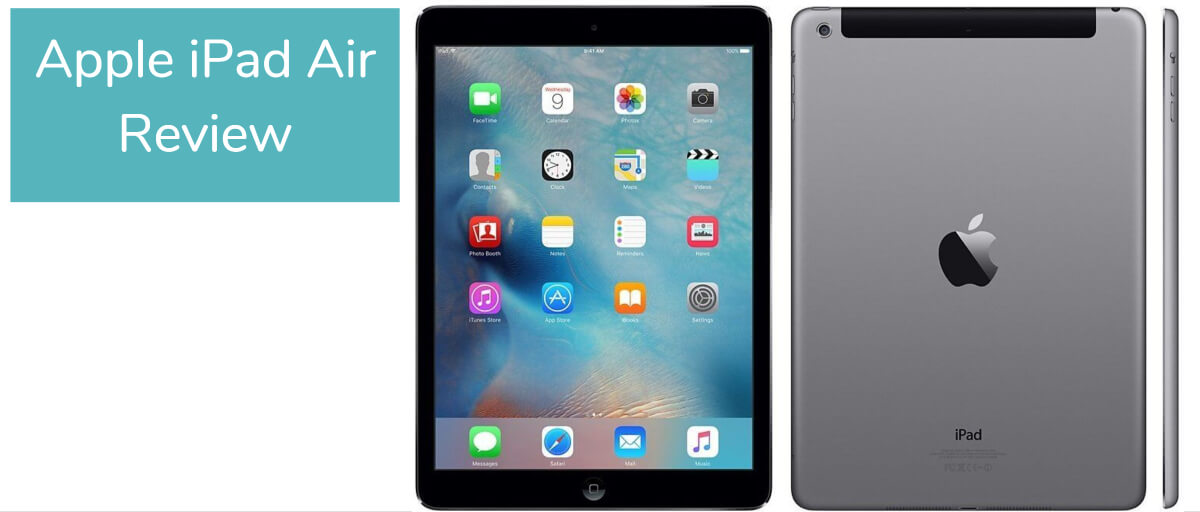Table of Contents
Last Updated on March 29, 2020
Along with slick, user-friendly interfaces, one of Apple’s calling cards is a focus on creating thinner, lighter devices than the competition. The iPad remains the most recognizable tablet line on the market, but Apple clearly isn’t ready to rest on its laurels just yet.
The iPad Air, as the name suggests, is a continuation of the design philosophy first introduced with the Macbook Air. It sure has style, but does it have the substance to back it up?
Hands-On Impressions
The iPad Air is a fairly typical Apple device, which is to say that it’s extremely well-made. The 9.4-by-6.6 inch aluminum unibody, despite being a razor-thin 0.29 inches, feels sturdy and has very little flex.
The overall design is quite familiar, closely resembling a scaled-up iPad Mini, and it’s every bit as light as you’d expect. At 1.03 pounds, it’s extraordinarily comfortable compared to tablets like the 1.49-pound Microsoft Surface 2 or 1.33-pound Google Nexus 10.
Tablet Tour
The layout of the iPad Air is similar to Apple’s other tablets. The power button is up top, along with a standard 3.5-millimeter headphone jack and dual microphones.
The rotation lock switch and volume rocker are placed along the top of the right edge. The stereo speakers have migrated to the bottom edge, flanking a standard Lightning port. As is generally the case in comparison to tablets from some other manufacturers, Apple’s iPad Air is somewhat lacking in terms of connectivity and storage options.
Resolving the Details
The introduction of the Retina display was a huge boost for Apple, and the iPad Air’s 9.7-inch Retina display is still excellent. The 2,048-by-1,536 resolution doesn’t quite measure up compared to tablets like the 2014 Samsung Galaxy Note 10.1 or Google Nexus 10, both of which sport brilliant 2,560-by-1,600 pixel displays, but the difference is minimal at best.
The iPad Air’s IPS display features vibrant, accurate colors, excellent viewing angles, and responsive touch controls.
Under the Hood
The iPad Air benefits from the latest and greatest of Apple’s performance technology, namely the dual-core A7 processor. The 1.4-gigahertz chip, slightly upgraded over the iPhone 5’s 1.3-gigahertz hardware, is paired with a gigabyte of RAM and an M7 motion-tracking coprocessor.
Apple claims the new chip delivers twice the performance of the previous model, and that certainly looks to be the case after a tablet comparison. Humdrum activities zip along at an impressive pace, and even hardware-intensive games and other apps are silky smooth.
Comparison with Previous Models
Progress for the Apple iPad line has generally been incremental, with each iteration offering a few substantive changes. The iPad 2 brought a slightly slimmer design, a front-facing camera, and a significant improvement in performance thanks to a dual-core A5 processor.
The iPad 3 brought the much-ballyhooed Retina display to the tablet, along with 4G capability and a modestly improved A5X processor. The iPad 4 introduced the Lightning connector to the iPad line, as well as small improvements to performance.
The iPad Air brings about the most substantial changes yet, and a tablet comparison between the Air and its predecessors is impressive. The device is significantly lighter and thinner, and the Air’s A7 processor represents a huge upgrade in performance over the previous chips.
iPad Alternatives
Being the latest and greatest Apple tablet, the iPad Air already has a built-in market of iOS enthusiasts. However, there are several intriguing alternatives among both Android and Windows 8 devices. Google’s Nexus 10 and Samsung’s 2014 Galaxy Note 10.1 offer displays with superior pixel counts, and both panels are every bit as brilliant as Apple’s Retina display.
Their hardware is also impressive, though neither offers the consistently smooth, zippy experience of the iPad Air. Windows 8-based alternatives are headlined by the Microsoft Surface 2 and Nokia Lumia 2520.
If you intend to use your tablet for productivity purposes, Windows 8 tablets are the clear winner. However, neither can match the iPad Air in a head-to-head tablet comparison. While both have excellent displays, their 1080p resolutions can’t match the Retina display.
They’re also much heavier and thicker than the iPad Air, and again they fail to match the Air’s powerful performance.

